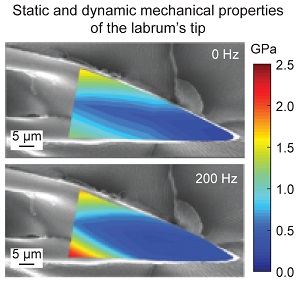bottom shows storage modulus of the labrum’s tip. The maps of nanohardness and tan δ are not shown. It is noted that elastic modulus and nanohardness decrease along the labrum, with end of the tip being most compliant and softest. Across the labrum, the properties are lowest in the middle. It is also noted that the labrum gets stiffer at higher frequencies. It is believed that the more compliant and softer end of the tip may cause lesser pain while piercing the host, because it will deform the skin lesser. The lesser deformation sensed by the nerve endings in the skin, will cause lesser pain. The end of the tip may also be compliant and soft because of the fact that it is used for sensing blood vessels inside the host. Furthermore, the stiffer and harder sides of the tip will also help the labrum to resist bending/buckling during piercing. Finally, increase in stiffness at the high frequency may maintain lower deformation at higher stresses.

Figure 1: Mechanical property maps of the labrum’s tip. The top presents elastic modulus and the bottom presents storage modulus 4.
Proposed Schematic of Microneedle: It is believed that the combination of the pre-piercing numbing, the fascicle’s serrated design, the vibratory actuation, and the graded and frequency dependent mechanical properties of the labrum’s tip is the mechanism behind the painless piercing. The serrated design and vibratory actuation are believed to lower the insertion force, which along with the pre-piercing numbing and the mechanical properties gradient along the tip of the labrum are believed to reduce the pain.
Based on this mechanism, a mosquito-inspired, vibrating, viscoelastic microneedle with serrated design and material gradient has also been proposed. In the proposed design, the microneedle has a channel for fluid passage and serrated design, similar to the labrum and the maxilla. The microneedle is made up of a viscoelastic material having material gradients similar to that of the labrum. The microneedle is also accompanied by a numbing agent secretor, which together are enclosed within a thick covering, similar to the hypopharynx and the labium, respectively.
References: 1. Stork, N. E. Biodiversity. in Encyclopedia of insects (eds. Resh, V. H. & Carde, R. T.) (Elsevier Science & Technology, 2009).
2. Durden, L. A. & Mullen, G. R. Introduction. in Medical and Veterinary Entomology (eds. Mullen, G. R. & Durden, L. A.) 1–12 (Academic Press, 2009).
3. Ito, J., Ghosh, A., Moreira, L. A., Wimmer, E. A. & Jacobs-Lorena, M. Transgenic anopheline mosquitoes impaired in transmission of a malaria parasite. Nat. 417, 452–455 (2002).
4. Gurera, D., Bhushan, B. & Kumar, N. Lessons from Mosquitoes’ Painless Piercing. (in review) (2018).